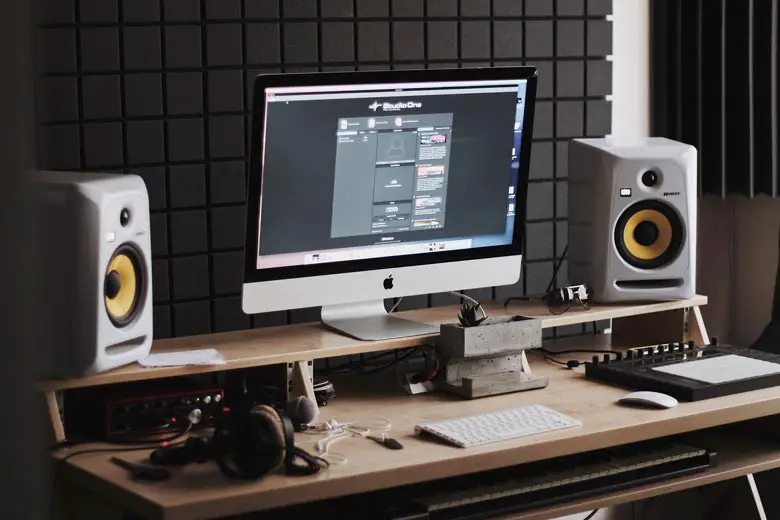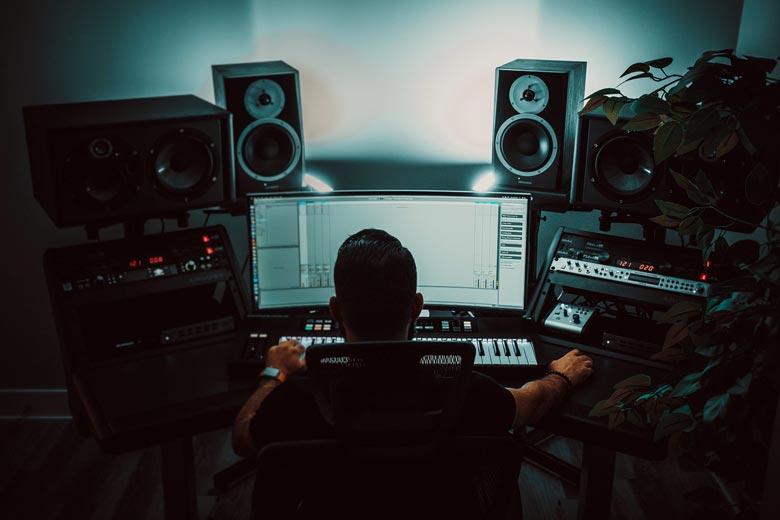Studio monitors are essential components of any audio-mixing or home studio setup due to their specialized construction and features. They can give you a clear picture of the tonal qualities of your sound and help you mix music for different settings, genres, and devices. However, you may be wondering whether they have any bass and can handle lower-end frequencies well.
Studio monitors have bass, but it’s usually not as strong as on hi-fi speakers. They have a flat frequency response designed to give the most neutral tonal features to help producers judge the quality of music. They’re not playback devices on which you can tweak the frequencies to color the sound.
Read on to learn more about the qualities and features of studio monitors and why they may have weak bass compared to other speakers. I’ll also offer some tips on how to improve bass on your studio monitors.

The Frequency Range of Studio Monitors
Since studio monitors aren’t generally considered playback devices for casual listening, they need to have different specs from regular speakers and headphones. Speakers are designed to accentuate bass and treble to give listeners the quality they want, not what the producers crafted in the studio.
On the other hand, audio engineers and producers use studio monitors to listen critically and see how the produced music sounds on a wide range of devices and how the listeners will perceive it.
That’s why they have to produce the sound as accurately as possible rather than to sound good.
They should reproduce sound the way it was recorded, without enhancing anything or making it sound better.
That said, it doesn’t mean studio monitors don’t have any bass.
Studio monitors come in a wide variety of designs and specs with different frequency response ranges, which is what gives you bass. If you want a stronger bass, look at the monitor’s specs and choose ones with a boosted low-end.
However, since studio monitors usually are close-range devices, they don’t give you pounding bass the way speakers do.
These devices have a crossover that ensures low-frequency and high-frequency signals get to the corresponding loudspeaker (tweeters, woofers, and subwoofers). However, the listener should be close to the monitors to hear all the frequencies.
Since they have a flat frequency response, they output all frequencies equally without cutting or boosting anything.
The woofers inside the studio monitors can reproduce frequencies between 40Hz to 5kHz. This frequency range shows that although they can handle the bass, it’s not as strong as what you’ll have in commercial hi-fi speakers.
In a larger room or open space setting, you may not hear much low-frequency (bass) from near-field studio monitors.
This is one of the reasons studio monitors aren’t the best for parties, for example.

How To Get a Stronger Bass Out of Your Studio Monitors
Although studio monitors have a weaker bass due to their designs and purposes, you can accentuate bass frequencies using different methods.
However, the final result depends on your goal and desired bass quality. So, you need to experiment with different settings to get it right.
Get the Placement Right
As mentioned, most studio monitors are designed for near-field listening with mixing and mastering in mind. Ideally, you should sit close to your studio monitors.
They should usually be placed within one or two meters (3.28–6.56 ft) of your ears in such settings, even on the mixing desk.
Another thing you should consider is their distance from each other. Since you want to have the most accurate bass, you should place them symmetrically to allow low-end frequencies to reach your ears simultaneously.
You should also maintain this symmetry in their placement relative to the back walls. For example, if one speaker is two feet (0.61 m) from its back wall, the other should also be the same distance.
If you place the monitors at the corners, make sure they’re at the same angle to avoid discrepancies in the frequency response. This way, even if the bass is weak, it’ll be even and undistorted.
Generally, experts don’t recommend placing speakers too close to the walls. However, this placement will give you a more robust and louder bass because the bass waves bounce off the walls.
Your sitting and listening area is as vital as the monitor placement.
Follow the triangle rule, according to which you should make an equilateral triangle with the two monitors and your sitting spot. Don’t place your listening area against a wall to avoid unwanted resonances.
And most importantly, your monitors should be at eye level with tweeters pointing toward your ears.
Want more in-depth info on how to place monitors for a home studio? Watch this helpful video:
Get Larger Studio Monitors
Larger monitors have bigger cones and woofers to give you a more robust bass. That’s particularly important if your room is large, so you can place them anywhere.
Pay particular attention to the drivers’ size as they play an essential role in reproducing low-frequency signals. In addition, you can play your music louder, provided that you have good sound insulation to avoid disturbing your neighbors. This way, you’ll get a stronger bass.

This 8-inch (20.32 cm) Yamaha HS8 Monitor (available on Amazon.com), is a favorite as it covers the low-end frequencies effectively.
With a 38Hz-30kHz frequency response and a Bass Reflex system, this monitor will give you the bass quality you seek.
Related article: Can You Use Hi-Fi Speakers As Monitors?
Place Your Studio Monitors on Stands
In addition to the placement of monitors, the surface you put them on is also paramount. That’s because the surface below and around the monitors will significantly affect low-end frequencies by absorbing or distorting them.
Therefore, you should avoid placing them on the boxes they come in or even putting them on wooden shelves.
Ideally, you should have dedicated speaker stands that are sturdy enough to absorb vibrations that distort low frequencies. Even if you put them on your mixing desk, they should be on dedicated stands.
Check out these Pyle Dual Studio Monitors (available on Amazon.com) that feature tripods for added stability. Its sturdy construction and vibration-reducing design ensure you won’t get unwanted distortion.
Get a Subwoofer
Adding a subwoofer, which exclusively outputs bass frequencies, can be a great solution to accentuate low frequencies. That’s particularly necessary if you have small studio monitors with drivers that are smaller than 8 inches (20.32 cm).
The smaller the driver, the weaker its ability to produce low-end frequencies. So, you’ll help create more bass and crossover without adding volume.
However, don’t go overboard with bass, as it can distort the final result. The best crossover frequency will be around 80Hz to avoid having too much bass that affects the entire piece.
That said, try to adjust the subwoofer settings to match your goals, be it mixing or pure listening.

Treat Your Room Acoustics
No matter how much you take care of your studio monitor’s settings and placement, if your room acoustics aren’t right, you won’t get the sound quality you want, bass included.
While room dimensions can play a significant role in getting a decent bass, it’s not always under our control. However, we can tweak some other room features to get better bass.
You can place bass traps (link to Amazon) in areas with the most resonance issues, such as corners. You could also use adjustable bass traps to absorb different frequencies.
Remember not to go overboard and dampen all resonances by placing bass traps everywhere, as you may end up with a deadened space. Trust your ears and go with whatever feels natural.
Final Thoughts
Bass and treble are primarily achieved by tweaking the original frequencies to give the listener their desired sound quality. They aren’t essential in studio monitors, which need to reproduce sound accurately and faithfully.
Since studio monitors are close-range devices, you need to place them near your listening area to give you the best low-frequency bass. You could also tweak the monitor’s settings and your room acoustics to get the pounding bass you want.
They are made for a specific purpose and generally shouldn’t be used instead of PA speakers, Hi-Fi speakers, or other stuff like that.